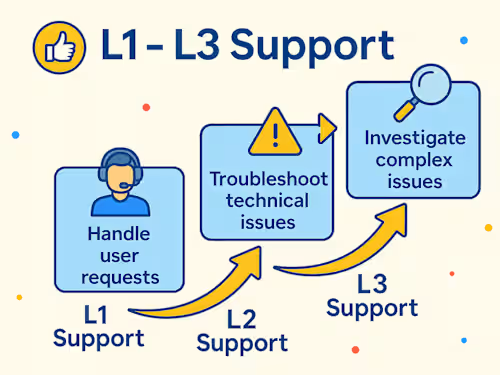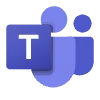
IT Support L1-L3
Contact for pricing
About this service
Summary
An MSP's L1–L3 IT Support provides a structured, escalation-based service model that ensures efficient resolution of technical issues—from basic user support (L1) to advanced infrastructure troubleshooting (L3). This tiered approach enhances service quality, reduces downtime, and ensures expert-level resolution for complex problems. It delivers proactive, cost-effective support that aligns with SLAs and drives operational reliability for the customer.
Process
Overview of L1-L3 IT Support by an MSP We offer tiered IT support to manage client environments effectively. The L1-L3 structure allows for escalation-based resolution, ensuring cost-effective, responsive, and expert-driven service delivery.
L1 Support – Frontline Helpdesk (Basic Level) Purpose: L1 is the first point of contact for all users. It handles basic, routine issues and ticket triage.
Responsibilities: • Receiving tickets via email, phone, chat, or portal. • Basic troubleshooting (password resets, printer issues, software installation). • Logging incidents and categorizing them accurately. • Guiding users through simple procedures or knowledge base articles. • Performing initial diagnostics using scripts or remote tools. • Escalating unresolved or complex issues to L2.
Tools Used: • Ticketing System (e.g., Zendesk, Freshservice, ConnectWise) • Remote Support Tools (e.g., AnyDesk, TeamViewer) • Knowledge Base / SOPs
L2 Support – Technical Expertise (Intermediate Level) Purpose: L2 provides in-depth troubleshooting for more complex user and system issues not resolved at L1.
Responsibilities: • Handling tickets escalated by L1. • Root cause analysis for recurring or systemic issues. • Managing user accounts, group policies, file shares, and email configurations. • Troubleshooting network connectivity, security alerts, OS errors. • Coordinating with on-site resources if hardware interaction is needed. • Documentation of fixes for the knowledge base.
Common Tasks: • OS and application error resolution • Email delivery issues (e.g., Exchange, Outlook, M365) • VPN configuration problems • Performance and system resource monitoring
L3 Support – Expert-Level and Escalation Support (Advanced Level) Purpose: L3 support involves high-level engineering support and is responsible for deep technical fixes, system design changes, and critical incidents.
Responsibilities: • Final escalation point for complex and critical issues. • Troubleshooting across servers, databases, virtual environments, and cloud platforms. • Implementing and reviewing advanced scripts, automation, and patches. • Interacting with vendors (e.g., Microsoft, VMware, Cisco) for escalated support. • Change management and impact analysis. • Security incident response and remediation.
Technologies Handled: • Active Directory, DNS, DHCP, SCCM, Intune • VMware, Hyper-V, Azure, AWS, Backup Systems • SIEM integration, Firewall logs, Zero-day patching • PowerShell scripting, GPO, Exchange Online
🔄 End-to-End Process Flow: How L1 → L2 → L3 Works Step Activity Handled by Description
1️⃣ Ticket Logged L1 User submits issue via call/email/portal
2️⃣ Basic Troubleshooting L1 Attempt resolution using standard procedures
3️⃣ Escalation L1 → L2 If unresolved, escalated with notes & logs
4️⃣ Advanced Troubleshooting L2 Investigate deeper using system tools
5️⃣ Resolution or Escalation L2 → L3 Resolved or escalated to L3 if critical
6️⃣ Root Cause Fix L3 Apply permanent fix, patch, or workaround
7️⃣ Documentation & Closure L1/L2/L3 Ticket closed with documented solution
🏆 Benefits of Tiered Support in MSP Model
• Efficient resource utilization (L1 handles volume, L3 focuses on depth)
• Cost optimization for clients
• Fast response and resolution due to escalation workflows
• 24/7 support capabilities with dedicated roles
• Improved user satisfaction and SLA compliance
What's included
End-to-End IT Helpdesk & Technical Support (L1–L3)
This L1–L3 IT Support offering delivers end-to-end issue management, from frontline helpdesk services to expert-level infrastructure troubleshooting. It ensures rapid response, efficient escalations, and reliable problem resolution, enabling businesses to maintain high IT availability, performance, and user satisfaction — all while aligning with SLAs and ITIL best practices.
Skills and tools
IT Specialist
Technical Support Specialist
Healthcare IT Support Specialist

AWS

Azure

Microsoft Office 365

Microsoft Teams

VMware
Industries
IT Infrastructure
Healthcare
Manufacturing
